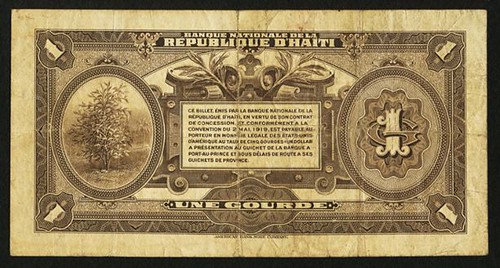
PREV ARTICLE
NEXT ARTICLE
FULL ISSUE
PREV FULL ISSUE
THE HAITIAN DOLLAR DOESN'T EXISTEconomist JP Koning recently blogged about the Haitian dollar, a nonexistent abstract unit of account. Here's an excerpt. See the complete article online for more. -Editor

Haiti is home to a strange monetary phenomenon. Shopkeepers and merchants set prices in the Haitian dollar, but there is no actual thing as the Haitian dollar. I've written before about an exotic type of unit-of-account known as an abstract unit of account. A nation's unit of account is the symbol used by its citizens and businesses to advertise and record prices. Here in Canada we use the $ while in a country like Japan people use the ¥. The national unit of account almost always corresponds to the national medium-of-exchange. In both Canada and Japan, the $ and the ¥ amounts advertised in shop aisles are embodied by physical dollar and yen banknotes and coins. Abstract units of account, on the other hand, don't correspond to anything that exists. In the UK, for instance, race horse auctions are priced in guineas, a gold coin that hasn't been minted in over two centuries. The guinea is a ghost money, an accounting unit that according to John Munro is "calculated according to the precious metal content of some famous, once highly favoured coin of the past than no longer circulates." Other examples of abstract units of account include include Chile's Unidad de Fomento, or UF, and Angolan macutes. Like the guinea, the Haitian dollar is an abstract unit of account. I should warn you that I've never been to Haiti--all of this comes from what I've read in tourist guides, newspapers, Haitian blogs, and an academic paper on the topic from Federico Neiburg. But from what I understand, it is quite common for prices in Haiti to be set in a unit referred to as the 'Haitian dollar.' However, there is no corresponding Haitian dollar banknotes or coins. The U.S. dollar and the Haitian gourde, a currency managed by Haiti's central bank, circulate in Haiti and are used to consummate all payments. But the Haitian gourde is not the same as the Haitian dollar. How does this work in practice? Say that a restaurant is selling sandwiches for fifteen Haitian dollars. Paying with Haitian dollars is impossible--they don't exist--so some other route must be taken to complete the deal. Haitians have spontaneously adopted a rule of thumb that the Haitian dollar is equal to five Haitian gourdes. So to pay for the sandwich, it will be necessary to hand over 75 gourdes (H$15 x 5$H/HG). A certain degree of mental gymnastics is thus required of Haitians, since sticker prices must always be multiplied by five (to arrive at the gourde amount) and banknotes held in a wallet divided by five (to arrive at the Haitian dollar amount). For foreigners, this can be confusing, but for Haitians the motley of U.S. dollars, gourdes, and the Haitian dollar unit of account has become second nature. So how did this system come about? Glad you asked... -Editor
Where does the practice of using the Haitian dollar come from? I wasn't aware of this, but during WWI the U.S. invaded Haiti, occupying it till 1934. There was a strong German mercantile presence in Haiti and apparently the U.S. authorities feared that Germany might take over. By 1918 the government's gourdes had become "so worn and torn" that a shortage of banknotes arose. As part of a 1919 U.S.-initiated monetary reform, all previous issues of gourdes were to be replaced by a new issue by the Banque Nationale de la Republique d'Haiti, which by then was owned and controlled by New York-based City Bank (and would eventually become Citigroup). The BNRH was granted a monopoly on banknote issuance, which meant that the Haitian government could no longer print its own currency. The new banknotes were to be convertible into U.S. dollars at a rate of five gourdes to the dollar, a promise that the BNRH printed on the face of each bill, as the images below illustrate. 

"This bill issued by the National Bank of the Republic of Haiti, under its concession contract and conforming with the agreement of May 2, 1919, is payable to the holder in legal money of the United States at the rate of five gourdes to the dollar upon presentation to the bank's office in Port-au-Prince or, after a delay, at its provincial branches." I hadn't noticed this January 29, 2019 post. Found via the February 26, 2019 issue of News & Notes from the Society of Paper Money Collectors. -Editor
To read the complete article, see:

Wayne Homren, Editor The Numismatic Bibliomania Society is a non-profit organization promoting numismatic literature. See our web site at coinbooks.org. To submit items for publication in The E-Sylum, write to the Editor at this address: whomren@gmail.com To subscribe go to: https://my.binhost.com/lists/listinfo/esylum All Rights Reserved. NBS Home Page Contact the NBS webmaster 
|